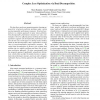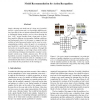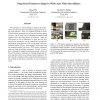CVPR
2012
IEEE
12 years 9 months ago
2012
IEEE
We describe a novel max-margin parameter learning approach for structured prediction problems under certain non-decomposable performance measures. Structured prediction is a commo...
CVPR
2012
IEEE
12 years 9 months ago
2012
IEEE
We present a discriminative latent topic model for scene recognition. The capacity of our model is originated from the modeling of two types of visual contexts, i.e., the category...
CVPR
2012
IEEE
12 years 9 months ago
2012
IEEE
We propose a nonparametric framework based on the beta process for discovering temporal patterns within a heterogenous video collection. Starting from quantized local motion descr...
CVPR
2012
IEEE
12 years 9 months ago
2012
IEEE
Simply choosing one model out of a large set of possibilities for a given vision task is a surprisingly difficult problem, especially if there is limited evaluation data with whi...
CVPR
2012
IEEE
12 years 9 months ago
2012
IEEE
We present a new pedestrian detector that improves both in speed and quality over state-of-the-art. By efficiently handling different scales and transferring computation from tes...
CVPR
2012
IEEE
12 years 9 months ago
2012
IEEE
Top-down visual saliency facilities object localization by providing a discriminative representation of target objects and a probability map for reducing the search space. In this...
CVPR
2012
IEEE
12 years 9 months ago
2012
IEEE
We introduce two novel methods to improve the performance of wide area video surveillance applications by using scene features. First, we evaluate the drift in intrinsic and extri...
CVPR
2012
IEEE
12 years 9 months ago
2012
IEEE
This paper focus on understanding human visual system when it decodes or recognizes facial expressions. Results presented can be exploited by the computer vision research communit...
CVPR
2012
IEEE
12 years 9 months ago
2012
IEEE
Many human action recognition tasks involve data that can be factorized into multiple views such as body postures and hand shapes. These views often interact with each other over ...
CVPR
2012
IEEE
12 years 9 months ago
2012
IEEE
We address the problem of multi-person dataassociation-based tracking (DAT) in semi-crowded environments from a single camera. Existing trackletassociation-based methods using pur...



